Difference between revisions of "Bonded leather"
| (11 intermediate revisions by one user not shown) | |||
| Line 5: | Line 5: | ||
==Leather fibres== | ==Leather fibres== | ||
| − | + | When [[shaving|leather is shaved]] in the [[leather production|tannery]] it produces a large amount of leather fibres. | |
| − | ==Bonded leather== | + | ==Bonded leather - Blended leather - Leather board== |
| − | + | Bonded leather (also called "reconstituted leather" or "blended leather") is a material consisting of leather fibres and binders. It's produced in rolls and should have a leather fibre content of at least 50%. | |
| − | + | The leather-like properties of the material, its homogeneous structure, the favourable price and the ability to process it into sheets and/or rolls make the use of leather fibres attractive. Another plus point is that it is produced from waste during [[ leather production]]. | |
| − | + | Bonded leather and leather boards are produced in [[Thickness of leather|thicknesses]] of 0.25 to 6 millimetres. | |
<p align=center> | <p align=center> | ||
| − | + | [[bild:lederfliesen-001.jpg|500px]] | |
| − | [[bild:lederfliesen-001.jpg| | + | |
</p> | </p> | ||
<p align=center> | <p align=center> | ||
| − | + | Bonded leather [[Leather floors -Leather tiles - Leather panels|flooring]] with [[Embossed leather|embossing]].''<br></p> | |
<p> </p> | <p> </p> | ||
| − | + | Bonded leather is mainly used as a material for heels, soles and other non-visible components of [[leather shoes|shoes]]. Other processors are the [[leather furniture|furniture industry]] and [[Leather book cover|bookbinding]] companies. Bonded leather is used for book covers, [[Leather floors -Leather tiles - Leather panels|floor panels]] and [[Leather wallpaper|wall panels]]. In the furniture sector, leather fibres only appear at the cheap end of the market. | |
| − | + | However, such materials cannot be sold as "[[leather#What materials can be called leather?|genuine leather]]", even if genuine leather fibres are a component. | |
| − | + | ||
| − | + | ||
| − | + | ||
| − | + | ||
<p align=center> | <p align=center> | ||
| − | [[bild:Stühle-Lefa-07.jpg| | + | [[bild:Stühle-Lefa-07.jpg|500px]] |
| − | + | ||
</p> | </p> | ||
<p align=center> | <p align=center> | ||
| − | '' | + | [[bild:Stühle-Lefa-05.jpg|500px]] |
| + | </p> | ||
| + | <p align=center> | ||
| + | ''A film on an easily tearing fibre composite.''<br></p> | ||
<p> </p> | <p> </p> | ||
| − | + | The surface consists of a film impressed with [[Leather hair pores - Hair follicles|hair pores]] and the material below is made up of leather fibres, which are connected with a binder. The material can be torn easily with two fingers as the fibres do not have as strong a bond as real leather. The fibres "stick" only to each other and are not naturally fused together and do not have the [[leather quality|stability of leather]]. | |
| − | + | ||
==Recycled leather== | ==Recycled leather== | ||
| − | + | Relatively inexpensive leather items are offered for sale with the description "recycled leather". This sounds as if used leather objects are being processed into new products. This may be true for some [[Leather accessories|accessories]], but they are not sold as "recycled leather". | |
| − | The products sold under the name "recycled leather" or "recycling leather" are divided into two | + | The products sold under the name "recycled leather" or "recycling leather" are divided into two: those made from bonded leather and also [[artificial leather with leather fibres on the reverse]]. |
| − | In both cases | + | In both cases, if the term is used without further description, it does not comply with the [[Leather#What materials can be called leather?|labelling requirements]] for leather. |
==Regenerated leather== | ==Regenerated leather== | ||
| − | In the online trade the term "regenerated leather" | + | In the online trade, the term "regenerated leather" often appears. It applies to leather fibre materials used for cheap upholstery, newspaper stands, bookcases and other accessories. But, without further description, this term contravenes the [[Leather#What materials can be called leather?|labelling requirements for leather]]. |
| − | + | ||
| − | + | ||
==[[Artificial leather with leather fibres on the reverse]]== | ==[[Artificial leather with leather fibres on the reverse]]== | ||
| − | In the [[leather furniture|furniture sector]], [[imitation leather]] is also offered, where leather | + | In the [[leather furniture|furniture sector]], [[imitation leather]] is also offered, where leather fibres are glued to the back in order to suggest a similarity to leather in the advertising. However, it is [[imitation leather|artificial leather]] without leather properties. |
<p align=center> | <p align=center> | ||
| − | [[bild:Echtes-Leder-Fasern-01.jpg| | + | [[bild:Echtes-Leder-Fasern-01.jpg|500px]] |
| − | [[bild:Echtes-Leder-Fasern-07.jpg| | + | </p> |
| + | <p align=center> | ||
| + | [[bild:Echtes-Leder-Fasern-07.jpg|500px]] | ||
</p> | </p> | ||
<p align=center> | <p align=center> | ||
''Artificial leather with leather fibres glued to the reverse.''<br></p> | ''Artificial leather with leather fibres glued to the reverse.''<br></p> | ||
<p> </p> | <p> </p> | ||
| − | |||
| − | |||
| − | |||
== Additional information == | == Additional information == | ||
* [[Leather#What materials can be called leather?|What materials can be called leather?]] | * [[Leather#What materials can be called leather?|What materials can be called leather?]] | ||
| − | * [[Genuine leather|What is genuine leather]] | + | * [[Genuine leather|What is genuine leather?]] |
| + | * [[Leather waste]] | ||
* [[Artificial leather with leather fibres on the reverse]] | * [[Artificial leather with leather fibres on the reverse]] | ||
* [[Imitation leather]] | * [[Imitation leather]] | ||
Latest revision as of 18:18, 25 January 2023
Contents
Leather fibres
When leather is shaved in the tannery it produces a large amount of leather fibres.
Bonded leather - Blended leather - Leather board
Bonded leather (also called "reconstituted leather" or "blended leather") is a material consisting of leather fibres and binders. It's produced in rolls and should have a leather fibre content of at least 50%.
The leather-like properties of the material, its homogeneous structure, the favourable price and the ability to process it into sheets and/or rolls make the use of leather fibres attractive. Another plus point is that it is produced from waste during leather production.
Bonded leather and leather boards are produced in thicknesses of 0.25 to 6 millimetres.
Bonded leather flooring with embossing.
Bonded leather is mainly used as a material for heels, soles and other non-visible components of shoes. Other processors are the furniture industry and bookbinding companies. Bonded leather is used for book covers, floor panels and wall panels. In the furniture sector, leather fibres only appear at the cheap end of the market.
However, such materials cannot be sold as "genuine leather", even if genuine leather fibres are a component.
A film on an easily tearing fibre composite.
The surface consists of a film impressed with hair pores and the material below is made up of leather fibres, which are connected with a binder. The material can be torn easily with two fingers as the fibres do not have as strong a bond as real leather. The fibres "stick" only to each other and are not naturally fused together and do not have the stability of leather.
Recycled leather
Relatively inexpensive leather items are offered for sale with the description "recycled leather". This sounds as if used leather objects are being processed into new products. This may be true for some accessories, but they are not sold as "recycled leather".
The products sold under the name "recycled leather" or "recycling leather" are divided into two: those made from bonded leather and also artificial leather with leather fibres on the reverse.
In both cases, if the term is used without further description, it does not comply with the labelling requirements for leather.
Regenerated leather
In the online trade, the term "regenerated leather" often appears. It applies to leather fibre materials used for cheap upholstery, newspaper stands, bookcases and other accessories. But, without further description, this term contravenes the labelling requirements for leather.
Artificial leather with leather fibres on the reverse
In the furniture sector, imitation leather is also offered, where leather fibres are glued to the back in order to suggest a similarity to leather in the advertising. However, it is artificial leather without leather properties.
Artificial leather with leather fibres glued to the reverse.
Additional information
- What materials can be called leather?
- What is genuine leather?
- Leather waste
- Artificial leather with leather fibres on the reverse
- Imitation leather







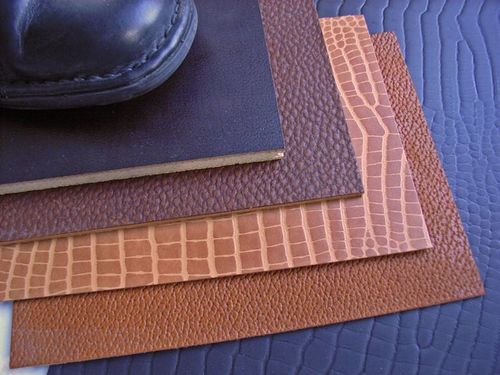
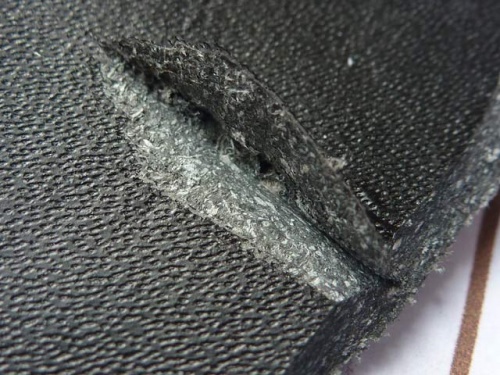
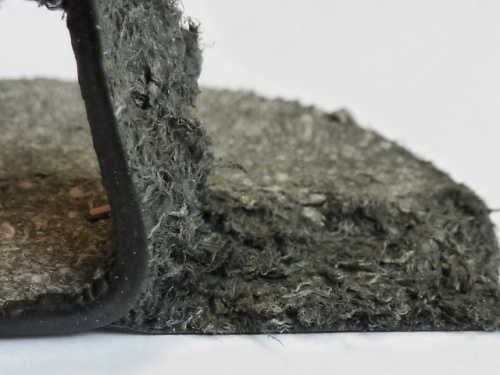
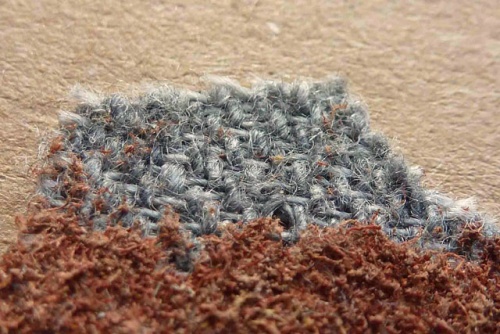
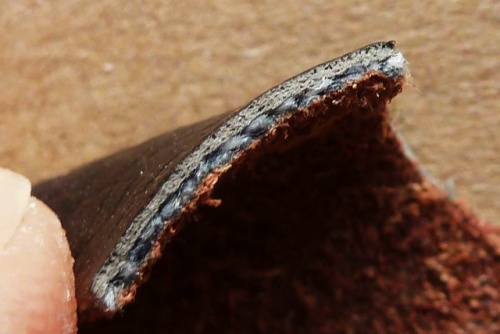

 a kotori web solution
a kotori web solution